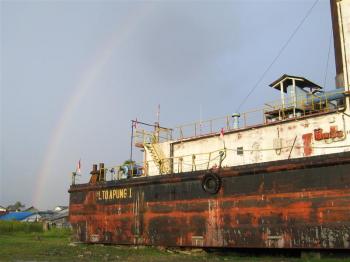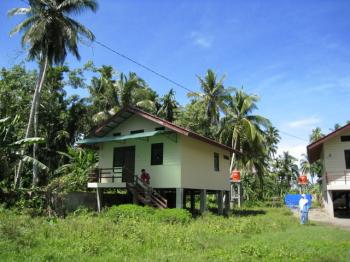Prior to the tsunami, a long standing, low level conflict existed within Aceh. Aji, a young Indonesian Red Cross volunteer at the time, recalls how he used to evacuate at least one corpse every day, victims of the fighting. After 29 years of conflict, that meant a lot of bodies. Instability raged across turbulent Aceh.
Then, on Boxing Day 2004, an earthquake measuring nine on the Richter scale struck just off the coast of Aceh, violently waking up the sea and sending not one but three monstrous waves up to 20 metres high many kilometres inland. At least 120,000 and maybe as many as 160,000 died in this one province of Indonesia – well over half of the global death toll of the tsunami that affected 13 countries.

 The 2,600 tonne boat
The 2,600 tonne boat
As the giant waves as high as six storey buildings decapitated towering palm trees and wiped out everything and everyone in its path, they also wiped out the conflict in Aceh. The enormity of the disaster took over everything. Conversations five years later rarely turn towards the conflict; it is always tsunami, tsunami, tsunami. After decades of conflict, that is saying something.
Within days, mass graves with tens of thousands of unidentified bodies filled up. A few miracle buildings were left standing, including a giant white mosque in Lhoknga, near Banda Aceh. The land was rearranged: where houses and palm trees once stood, there was nothing but water. A 2,600 tonne boat was carried five kilometres inland, where it still sits today. At least 30,000 people died in the capital of Banda Aceh alone. The city and surrounding countryside were completely and utterly destroyed.

 Banda Aceh before the tsunami
Banda Aceh before the tsunami
Five years later, the astounding and overwhelmingly positive fact is that if you don’t dig under the surface or notice the finer detail it would be hard to tell what happened in Aceh five years ago. Of course there are the subtle reminders, such as headless palm trees, and not so subtle reminders, like the massive boat 5km inland.
However there has been an incredible reconstruction effort that has pumped the city back to life – the few old buildings blending into the multitude of new ones, forming one vibrant and colourful city getting on with life. Streets from even two years ago are unrecognisable: they look so different now, so alive.

 Banda Aceh after the tsunami
Banda Aceh after the tsunami
The British Red Cross has rebuilt over 2,200 houses and supported over 34,000 people to restore their livelihoods in numerous communities across Aceh. In the rebuilt villages, almost every house new, life is moving on in leaps and bounds.
Take May Suriyati, 27, who has restarted her sewing business with the help of a cash grant from the British Red Cross. Her business has been so successful that she has built an extension on her Turkish Red Crescent house that now forms her tailoring shop, full of cupboards lined with colourful clothes made to order. The signs of recovery are clearly visible in both the personal and public faces of Aceh. May’s story is just one of many stories of recovery featured on the British Red Cross Tsunami anniversary site www.recoveringafuture.org.uk

 houses built on stilts for a safer future
houses built on stilts for a safer future
The tourist industry in the region has also begun to pick up, with visitors returning to the island of Sabang, famous for diving, and luckily relatively unscathed by the tsunami. It is encouraging to see tourists mingling with local people as they travel by ferry between Banda Aceh and the island that lies just off the coastline.
Although the emotional scars from the tsunami still run deep, it is both moving and awe-inspiring to see the incredible results of the tsunami recovery operation in Aceh five years after the disaster.